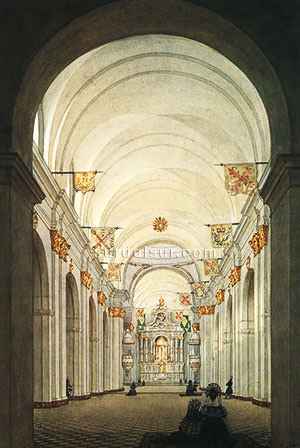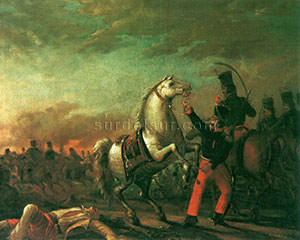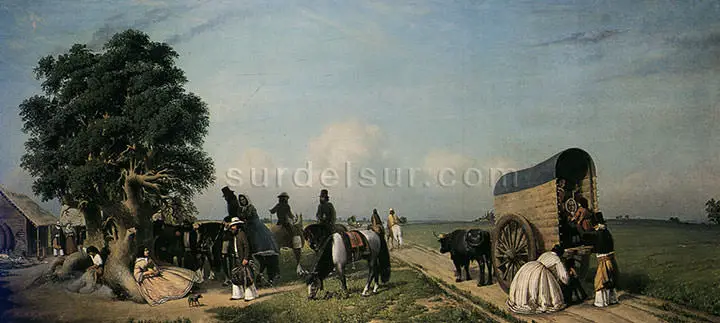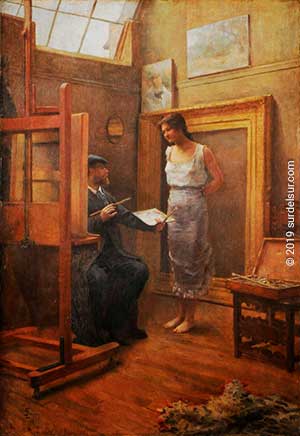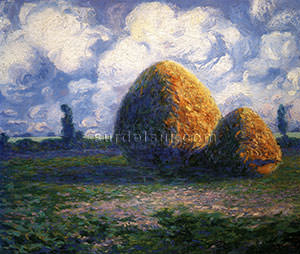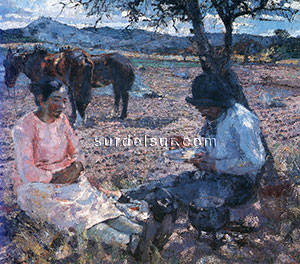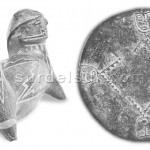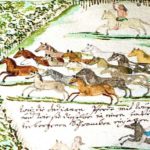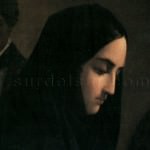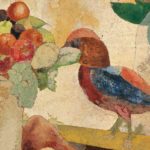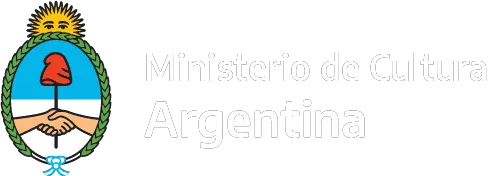Argentina Painting from 1810 to 1920 is the period that initiates with the May Revolution. Colonialism and religious motifs from Spanish Conquest were left behind. In 19th century Argentina painting, portraits and scenes of customs were the main themes.
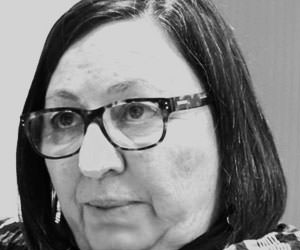
Article of the guest columnist for surdelsur.com
Introduction to Argentina painting from 1810 to 1920
Argentine painting from 1810 to 1920 is the stage that begins with the May Revolution. As from May Revolution -and under the influence of lines of thinking derived from French Revolution-, religious subjects, as mentioned for the colonial period, were less present; this time, pictorial activity mainly developed around portraits and scenes of customs.
This 19th century stage in Argentina painting, recognizes two periods:
- The first period extends from 1810 with the May Revolution, to the fall of Rosas in the Battle of Caseros in 1852. This period is represented mainly by European visual artists who inhabited our territory.
- The second period begins in 1852 with the end of the dictatorial government of Rosas, and begins the path towards the institutional order of Argentina. This period of Argentina fine arts is represented by Argentine painters and extends to 1920 with the rise of modernity.
1st PERIOD 1810-1852
19th Century Argentina Painting by Foreign Painters
A numerous group of foreign artists visited Argentina, living here for some time or settling down on a permanent basis; they could capture the types and customs of the region in their works. Here we show the most outstanding aspects of the 19th century Argentine painters and their work.
Emeric Essex Vidal (1791-1861)
An English naval officer, left watercolors which are a remarkable record of the Argentine past: Picturesque illustrations of Buenos Ayres and Montevideo
Carlos Enrique Pellegrini (1800-1875)
Arrived from France, after being hired as an engineer, but political reasons kept him from carrying out the planned works, so he devoted to painting, making several portraits, scenes of customs and vistas of the city. Plaza de la Victoria (frente al sud) (1829 -Victory Square (facing south)), Iglesia de Santo Domingo (1830 – Church of Santo Domingo) Doña Lucía Carranza de Rodríguez Orey (1831), Vista de Buenos Aires (1832 – View of Buenos Aires), Brigadier General Don Juan Manuel de Rosas (1833)
Adolfo D’Hastrel (1805-1875)
A french naval officer, gathered drawings and watercolors accompanied with texts in the book called Colección de vistas y costumbres del Río de la Plata (1875 – Collection of vistas and customs of Plata River). Su Esposa (His Wife), Autorretrato (Self Portrait)
César Hipólito Bacle (1790 – 1838)
Lithographer from Swiss origin, printed Trajes y costumbres del Río de la Plata (Garments and customs of the province of Buenos Aires) in his establishment, State Lithography(1828-1838), with the collaboration of his wife Andrea Macaire and Arturo Oslow, among others.
Raimundo Monvoisin (1790-1870)
Monvoisin french painter stood out among the foreign artists of the first half of the 19th century. The former lived in Buenos Aires and then went to Chile, painting Gaucho Federal and La porteña del templo (Porteña in Church), Autorretrato, Retrato de Juan Manuel de Rosas (1842 – Portrait of Juan Manuel de Rosas)
Mauricio Rugendas (1802-1858)
Rugendas german painter and drawer, visited Brazil, Mexico, Peru, Bolivia and Chile; we owe him Desembarco de pasajeros en Buenos Aires (Passengers disembarking in Buenos Aires), y Retrato de Mariquita Sánchez de Mendeville (1845 – Portrait of Mariquita Sánchez de Mendivillie.)
19 th Century Argentine Painting by Argentine Painters
It is also worth mentioning two Argentine artists:
Carlos Morel (1813-1894)
Argentine painter born in Buenos Aires, who collected his lithographs dealing with scenes of customs in Usos y costumbres del Río de la Plata (Usages and Customs of Plata River; 1844-1845), he painted portraits and recorded customs of the time, as in Payada de la pulpería y Combate de caballería en la época de Rosas (1839 – Cavalry Combat in Rosas’s Times)
Prilidiano Pueyrredón (1823-1873)
An Argentine architect, engineer and urbanist who was one of the most remarkable Argentine painters of 19th century; he sought to perpetuate the traditions of our land and the old customs of the Great Village.
Among his works are Payada de la pulpería (1857 – Portrait of Manuelita Rosas), Un alto en el campo (1861 – A Halt in the Countryside) and El baño (1865 – The Bath), a nude which was too daring for the time.
2nd PERIOD 1852-1920
Institutionalization of the Fine Arts of Argentina
As we mentioned at the beginning of the article, after the period of Rosas’s defeat, a second stage begins that accompanies the path towards the institutional order of Argentina. Starting in 1852, a group of visual artists acted in Buenos Aires, actively participating in the organization of artistic institutions. Under his impulse, the Sociedad Estímulo de Bellas Artes (Society for the Encouragement of Fine Arts) the Museo Nacional de Bellas Artes (National Museum of Fine Arts) and the La Academia (The Academy) were established. These artists used to study in Europe.
19th Century Famous Argentine Painters
New figures emerged, starred and forged the institutions dedicated to strengthening the activity of the finel arts in Argentina during the second half of the 19th century and the beginning of the 20th. Among others famous Argentine painters, we can evoke:
Eduardo Sivori (1847-1918)
Argentine painter born in Buenos Aires, he is one of the most important exponents, together with Ernesto de la Cárcova, of Argentine pictorial realism of the late 19th century. He is considered as the introducer of Naturalism in Argentina. Among his works, we can mention: El despertar de la criada (1887 – The Maid’s Awakening) and, in the last years, Mujeres bañándose (1916 Women Bathing), El bañado (The Marshland), with marked differences in relation to his first stage: a clear palette with high shading values allowed him to achieve a typical Pampa landscape.
Angel Della Valle (1852-1903)
Ángel Della Valle was an Argentine painter of the Generation of ’80. Together with Eduardo Sívori and other artists, he was a representative of pictorial realism. He included the countryside subjects in their works: Gauchos a caballo (Gauchos on Horse) and El juego del Pato, Paisanos (Countrymen) y La vuelta del malón (The Return of the Malón) are his most representative works.
Reinaldo Giudici (1853-1927)
Reinaldo Giudici was an Italian-Argentine painter, one of the initiators of Argentine painting and one of the founders of the Sociedad Estímulo de Bellas Artes, the initial name of the Academia Nacional de Bellas Artes de Argentina (National Academy of Fine Arts of Argentina). Giudice’s painting is of notable technical erudition with a naturalistic characteristic and a faithful reflection of reality Subiendo la cuesta (1883 – Going up the slope), La sopa de los pobres (Venecia) (1884 – The soup of the poor -Venice), La hilandera (1884 – The spinner)
Giudici and de La Carcova in their works, these artists merged elements from Neoclassicism, Romanticism, Naturalism: a formal repertoire from another cultural background adapted to this environment.
Ernesto de La Carcova (1866-1927)
Outstanding Argentine painter of realist style and also a teacher. He was the first director of the Academia Nacional de Bellas Artes (National Academy of Fine Arts) and founding director of the Escuela Superior de Bellas Artes (Superior School of Fine Arts). In the work of La Cárcova stands out Sin pan y sin trabajo (1894 – Without Bread and Without Work) which is the first work-related painting with the intention of social criticism in Argentine art. Paisaje (1902 – Landscape) and Naturaleza en silencio (1926 – Nature in silence) are a different part of his production.
Martín Malharro (1865-1911)
Born in Azul, province of Buenos Aires, the argentine painter returned from Paris, in early 20th century. The exhibition of his works, in 1902, is regarded as the moment when Impressionism appeared in Argentina.
La arboleda (The Grove), En plena naturaleza (1901 – In the Middle of Nature), Paisaje (1902 – Landscape) Paisaje (1907- Landscape), Paisaje 2 (1907- Landscape) Nocturno (1910 – Nocturne) are some of the works of Martín Malharro
With Malharro, Faustino Brughetti (1877-1956), Walter de Navazio (1887-1919) y Ramón Silva (1890-1919), the clear landscape was the protagonist of Argentine painting.
Fernando Fader (1882-1935)
Argentine painter and draftsman born in Burdeos, France, main follower of German Impressionism in our country. The artists with whom he made up the group known as Nexus, participated in the controversy on the possibility of a national art (which responded to a wider debate on Nationalism arising towards late 19th century) reaching its highest peak in the Exposición Internacional del Centenario de 1910 (International Exhibition for the Centenary of 1910).
Escena campestre (1915 – Country Scene) El corral de las cabras (1926 – The Corral of the Goats), Las playas de Guasapampa (1930 – The Beaches of Guasapampa )
Next report describes Argentine Painting since 1920 It characterized by the modernization of the plastic language in Argentina >>
References:
All graphic material in this report is edited digitally. The customized version by surdelsur.com shown on this page is performed based on the following documents:
- Constantin, María Teresa (Art historian) [Images] Collection of images belonging to Museums and other sources, provided by the report author. Buenos Aires, Argentina.
Bibliography;
Museum of Fine Arts, Digital Collection Arte del Siglo XX, (20th Century Art) Escuela Argentina

